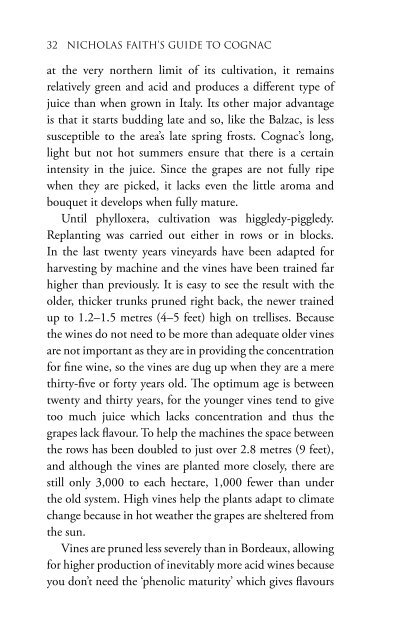You also want an ePaper? Increase the reach of your titles
YUMPU automatically turns print PDFs into web optimized ePapers that Google loves.
at the very northern limit of its cultivation, it remains<br />
relatively green and acid and produces a different type of<br />
juice than when grown in Italy. Its other major advantage<br />
is that it starts budding late and so, like the Balzac, is less<br />
susceptible to the area’s late spring frosts. <strong>Cognac</strong>’s long,<br />
light but not hot summers ensure that there is a certain<br />
intensity in the juice. Since the grapes are not fully ripe<br />
when they are picked, it lacks even the little aroma and<br />
bouquet it develops when fully mature.<br />
Until phylloxera, cultivation was higgledy-piggledy.<br />
Replanting was carried out either in rows or in blocks.<br />
In the last twenty years vineyards have been adapted for<br />
harvesting by machine and the vines have been trained far<br />
higher than previously. It is easy to see the result with the<br />
older, thicker trunks pruned right back, the newer trained<br />
up to 1.2–1.5 metres (4–5 feet) high on trellises. Because<br />
the wines do not need to be more than adequate older vines<br />
are not important as they are in providing the concentration<br />
for fine wine, so the vines are dug up when they are a mere<br />
thirty-five or forty years old. The optimum age is between<br />
twenty and thirty years, for the younger vines tend to give<br />
too much juice which lacks concentration and thus the<br />
grapes lack flavour. To help the machines the space between<br />
the rows has been doubled to just over 2.8 metres (9 feet),<br />
and although the vines are planted more closely, there are<br />
still only 3,000 to each hectare, 1,000 fewer than under<br />
the old system. High vines help the plants adapt to climate<br />
change because in hot weather the grapes are sheltered from<br />
the sun.<br />
Vines are pruned less severely than in Bordeaux, allowing<br />
for higher production of inevitably more acid wines because<br />
you don’t need the ‘phenolic maturity’ which gives flavours<br />
for table wine. Nevertheless, the grapes mustn’t be too<br />
green, they must have at least 8 per cent of alcohol. But too<br />
much manure must not be used and the vines must not be<br />
pruned too lightly to produce massive numbers of grapes,<br />
otherwise the balance will be disturbed, and the acid level<br />
will inevitably be reduced. Nevertheless the ‘natural’ yield<br />
now averages over 100 hectolitres for every hectare of vines,<br />
double the 1945 level and even then a fifth below the level<br />
recommended by viticulturists.<br />
The Saint-Emilion matures so late that even the relatively<br />
unripe <strong>Cognac</strong> grapes used to be ready for picking only in<br />
mid-October – though harvest is now up to three weeks<br />
earlier than a couple of decades ago thanks to global warming.<br />
The only limit to the date of the harvest is the frost, generally<br />
expected in late October, which, in a bad year like 1980, can<br />
ruin the quality of the wine. Harvesting machines were a<br />
natural choice for the region because the <strong>Cognac</strong>ais are not<br />
particularly interested in quality, but with early models the<br />
wines were rather ‘green’ for the very obvious reason that the<br />
machines were too violent and sucked in twigs and leaves as<br />
well as grapes. Opponents even alleged – incorrectly – that the<br />
hydraulic machinery was badly insulated and tended to leak<br />
tiny quantities of oil on to the grapes resulting in an oiliness<br />
which was inevitably exaggerated by distillation. But today<br />
the machines employ flayers which make the vines vibrate<br />
and don’t maul the bunches of grapes. Oddly, they can now<br />
be too selective and thus reject the greener grapes that used to<br />
prove useful in providing the right amount of acidity in the<br />
blend. They are ideal for harvesting the Ugni Blanc which<br />
has a thin skin, making it susceptible to oxidation. And their<br />
speed means that they can come in handy when, as in 1989<br />
and 2010 the alcohol levels are rising fast and early – and of


